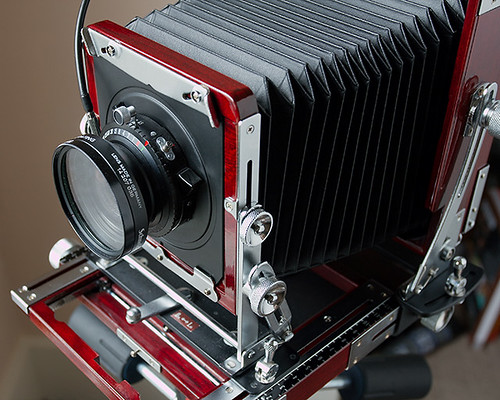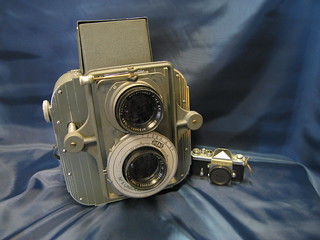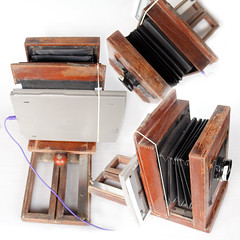Difference between revisions of "Large format"
m (Moved Glossary to the top of the page) |
|||
| (10 intermediate revisions by 7 users not shown) | |||
| Line 1: | Line 1: | ||
| − | {{ | + | {{glossary}} |
| + | {{Flickr image | ||
| + | | image_source=http://www.flickr.com/photos/mikefiction/458860956/in/pool-camerawiki/ | ||
| + | | image=http://farm1.static.flickr.com/236/458860956_e7fbb943af.jpg | ||
| + | | image_align=right | ||
| + | | image_text=[[Tachihara]] large format [[field camera]]<ref>[[Tachihara]] large format [[field camera]]</ref> | ||
| + | |image_by= Mike Fiction | ||
| + | |image_rights= creative commons | ||
| + | }} | ||
'''Large format''' means film that is generally at least 4x5 inches (or 9x12 cm). Film this size is generally used as individual sheets, rather than rolls as in smaller formats. (There are large rolls of film, though, used for such things as aerial photography.) Exposures on a large-format camera are made one at a time, using film loaded into film holders. | '''Large format''' means film that is generally at least 4x5 inches (or 9x12 cm). Film this size is generally used as individual sheets, rather than rolls as in smaller formats. (There are large rolls of film, though, used for such things as aerial photography.) Exposures on a large-format camera are made one at a time, using film loaded into film holders. | ||
| − | While there are many varied designs of large format cameras, there are two basic varieties: the monorail camera, and the [[field camera]]. A monorail camera uses a single round or square tube/rail as the base of the camera on which the front and rear sections slide back and forth to accommodate lenses of different focal length. A field camera design allows the camera to fold into itself to facilitate ease of storage and transport. The monorail camera design allows for greater versatility in camera movements, such as swing and tilt, but is typically large and heavy. The field design is usually smaller and lighter, sacrificing range of motion and rigidity. | + | While there are many varied designs of large format cameras, there are two basic varieties: the [[monorail_camera|monorail camera]], and the [[field camera]]. A monorail camera uses a single round or square tube/rail as the base of the camera on which the front and rear sections slide back and forth to accommodate lenses of different focal length. A field camera design allows the camera to fold into itself to facilitate ease of storage and transport. The monorail camera design allows for greater versatility in camera movements, such as swing and tilt, but is typically large and heavy. The field design is usually smaller and lighter, sacrificing range of motion and rigidity. |
| − | Specialized, and not as common, large format cameras come in different designs, such as the [[rangefinder_camera|rangefinder]] models made by Fotoman and other camera makers, [[pinhole_camera|pinhole]] box cameras, [[SLR|single lens reflex]] by [[Graflex]] and [[Arca | + | Specialized, and not as common, large format cameras come in different designs, such as the [[rangefinder_camera|rangefinder]] models made by Fotoman and other camera makers, [[pinhole_camera|pinhole]] box cameras, [[SLR|single lens reflex]] by [[Graflex]] and [[Arca Swiss]], and even [[TLR|twin lens reflex]] designs made by photographer Peter Gowland. |
Lenses for large format cameras range in focal length too numerous to list here, and of very different designs for a large variety of optical results. The main feature of a large format lens is that the image projection inside the camera must be large enough to accommodate the area of the film itself. This is referred to as the "image circle" and can vary according to lens focal length and design. For example, a lens with a focal length of 150mm may be designed to provide an image circle with a diameter of 230mm ([[http://www.schneideroptics.com/ecommerce/CatalogItemDetail.aspx?CID=164&IID=1830 Schneider APO-Symmar-L]]), large enough to cover a 4x5 inch sheet of film, or it may be designed to provide an image circle of 386mm in diameter ([[http://www.schneideroptics.com/ecommerce/CatalogSubCategoryDisplay.aspx?CID=169 Schneider Super Symmar-XL]]), enough to cover an 8x10 inch sheet of film. Many lens manufacturers have come and gone. As of 2009, three major manufacturers are still in production: [[Schneider]], [[Rodenstock]], and Fujinon. | Lenses for large format cameras range in focal length too numerous to list here, and of very different designs for a large variety of optical results. The main feature of a large format lens is that the image projection inside the camera must be large enough to accommodate the area of the film itself. This is referred to as the "image circle" and can vary according to lens focal length and design. For example, a lens with a focal length of 150mm may be designed to provide an image circle with a diameter of 230mm ([[http://www.schneideroptics.com/ecommerce/CatalogItemDetail.aspx?CID=164&IID=1830 Schneider APO-Symmar-L]]), large enough to cover a 4x5 inch sheet of film, or it may be designed to provide an image circle of 386mm in diameter ([[http://www.schneideroptics.com/ecommerce/CatalogSubCategoryDisplay.aspx?CID=169 Schneider Super Symmar-XL]]), enough to cover an 8x10 inch sheet of film. Many lens manufacturers have come and gone. As of 2009, three major manufacturers are still in production: [[Schneider]], [[Rodenstock]], and Fujinon. | ||
| + | {{Flickr_image | ||
| + | |image_source= http://www.flickr.com/photos/97974762@N00/3128737973/in/pool-camerawiki/ | ||
| + | |image= http://farm4.staticflickr.com/3102/3128737973_5c182ec425_n.jpg | ||
| + | |image_align= right | ||
| + | |image_text= Macvan Reflex 5x7 TLR | ||
| + | |image_by= John Bosko | ||
| + | |image_rights= with permission | ||
| + | }} | ||
| + | ==Film sizes== | ||
Typical standard film sizes for large-format cameras are: | Typical standard film sizes for large-format cameras are: | ||
| Line 35: | Line 52: | ||
*12x20 inches | *12x20 inches | ||
| − | Note that the size limit given here (4x5 inches) is arbitrary, since there is still sheet film available in smaller sizes (for instance, 6x9 cm); generally, though, such film is regarded as [[medium format]]. Also, keep in mind that what is currently considered "large format" was once considered to be average size; after all, when it was first introduced, the 35mm format was called "miniature". | + | Note that the size limit given here (4x5 inches) is arbitrary, since there is still [[Sheet film|sheet film]] available in smaller sizes (for instance, 6x9 cm); generally, though, such film is regarded as [[medium format]]. Also, keep in mind that what is currently considered "large format" was once considered to be average size; after all, when it was first introduced, the [[35mm|35mm format]] was called "miniature". |
| + | |||
| + | ==Digital option== | ||
| + | |||
| + | {{Flickr_image | ||
| + | |image_source= http://www.flickr.com/photos/slowtek/5639523224/in/pool-camerawiki/ | ||
| + | |image= http://farm6.staticflickr.com/5262/5639523224_2d8a9ee94c_m.jpg | ||
| + | |image_align= right | ||
| + | |image_text= typical amateur [[scanner camera|large format digicam]] | ||
| + | |image_by= Daniel Johnson | ||
| + | |image_rights= nc | ||
| + | }} | ||
| + | |||
| + | [[Scanner camera]]s are the digital option for large format. Some people tinkered their own large format digicams with a cheap flatbed scanner as camera back, attached to simple old [[view camera]]s. Professional solutions were offered for smaller but common large format frame sizes like 4×5", with [[scanback]]s easily attachable as back to many standard cameras for that size, or [[repro camera]]s like the [[scan 7000]] or the [[Leica S1]]. | ||
| + | |||
| + | The future of large format digital photography might be foil sensors which might be makeable at any size. | ||
| + | |||
| + | ==Notes== | ||
| + | <REFERENCES/> | ||
| + | ==Links== | ||
| + | *[http://www.largeformatphotography.info/forum/ LF Forum] | ||
| − | |||
[[Category: Large format|*]] | [[Category: Large format|*]] | ||
| + | [[Category: Film formats]] | ||
Latest revision as of 03:27, 23 March 2023

|
| Tachihara large format field camera[1] image by Mike Fiction (Image rights) |
Large format means film that is generally at least 4x5 inches (or 9x12 cm). Film this size is generally used as individual sheets, rather than rolls as in smaller formats. (There are large rolls of film, though, used for such things as aerial photography.) Exposures on a large-format camera are made one at a time, using film loaded into film holders.
While there are many varied designs of large format cameras, there are two basic varieties: the monorail camera, and the field camera. A monorail camera uses a single round or square tube/rail as the base of the camera on which the front and rear sections slide back and forth to accommodate lenses of different focal length. A field camera design allows the camera to fold into itself to facilitate ease of storage and transport. The monorail camera design allows for greater versatility in camera movements, such as swing and tilt, but is typically large and heavy. The field design is usually smaller and lighter, sacrificing range of motion and rigidity.
Specialized, and not as common, large format cameras come in different designs, such as the rangefinder models made by Fotoman and other camera makers, pinhole box cameras, single lens reflex by Graflex and Arca Swiss, and even twin lens reflex designs made by photographer Peter Gowland.
Lenses for large format cameras range in focal length too numerous to list here, and of very different designs for a large variety of optical results. The main feature of a large format lens is that the image projection inside the camera must be large enough to accommodate the area of the film itself. This is referred to as the "image circle" and can vary according to lens focal length and design. For example, a lens with a focal length of 150mm may be designed to provide an image circle with a diameter of 230mm ([Schneider APO-Symmar-L]), large enough to cover a 4x5 inch sheet of film, or it may be designed to provide an image circle of 386mm in diameter ([Schneider Super Symmar-XL]), enough to cover an 8x10 inch sheet of film. Many lens manufacturers have come and gone. As of 2009, three major manufacturers are still in production: Schneider, Rodenstock, and Fujinon.

|
| Macvan Reflex 5x7 TLR image by John Bosko (Image rights) |
Contents
Film sizes
Typical standard film sizes for large-format cameras are:
- 9x12 cm
- 4x5 inches
- 5x7 inches
- 8x10 inches
- 11x14 inches
Older, less common and Ultra Large Format film sizes are:
- 3.25x4.25 inches
- 6.5x8.5 inches
- 10x12 inches
- 14x17 inches
- 16x20 inches
- 18x22 inches
- 20x24 inches
Standard panoramic film sizes are:
- 4x10 inches
- 5x11 inches
- 7x17 inches
- 8x20 inches
- 12x20 inches
Note that the size limit given here (4x5 inches) is arbitrary, since there is still sheet film available in smaller sizes (for instance, 6x9 cm); generally, though, such film is regarded as medium format. Also, keep in mind that what is currently considered "large format" was once considered to be average size; after all, when it was first introduced, the 35mm format was called "miniature".
Digital option

|
| typical amateur large format digicam image by Daniel Johnson (Image rights) |
Scanner cameras are the digital option for large format. Some people tinkered their own large format digicams with a cheap flatbed scanner as camera back, attached to simple old view cameras. Professional solutions were offered for smaller but common large format frame sizes like 4×5", with scanbacks easily attachable as back to many standard cameras for that size, or repro cameras like the scan 7000 or the Leica S1.
The future of large format digital photography might be foil sensors which might be makeable at any size.
Notes
- ↑ Tachihara large format field camera